Importing a Japanese mobile phone
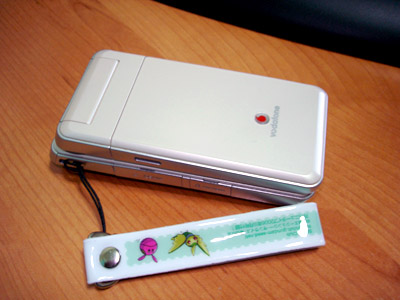
Vodafone 903SH
If you have been reading my blog since the b2 days, you would know that I own a Vodafone 903SH (the SH is for Sharp). At the time I got it, the phone was the latest 3G offering from Vodafone Japan and it’s equipped with a 3.2mp camera and all that jazz. I had to send mine to Japan for repairs some time ago and now I finally got it back today! Joy~~ I feel complete as a person once more. :P
Anyway, some people have been wondering about how to import Japanese phones for use in their own countries. Here are some things you should know first…
Japanese phones are dirt cheap. But only if you are living in Japan. Just take a look at Vodafone’s online store and you will see that most of their latest 3G offerings sell for less than 100 USD, with cameras ranging from ~2mp to 3.2mp. The most expensive phone available is 905SH, which is selling for ¥22,800 (about 200 USD), but that’s because it has a built-in TV tuner…
Cheap as they may be, if you going to import the phones, prepare to pay for 4 to 6 times the list price. Here’s why…
Firstly, Japanese phones are all SIM locked to their service providers. Their telecommunication laws are pretty strict about this. As Japanese firmwares are not designed to be unlockable, unlocking generally means that you have to get someone to reflash it with a hacked firmware or an unlocked firmware for that model from a different region. Very few phones are unlockable thus they are in great demand.
Secondly, most Japanese phones do not support GSM. They just have something against GSM. Don’t even try getting Japanese 2G phones because none of them can be used outside of Japan even if you somehow trick them into accepting a foreign SIM card (assuming they have a SIM card slot in the first place!) For 3G, Japan uses the W-CDMA standard, which is compatible with the UMTS 3G network used in Singapore, Hong Kong, Australia, UK and a whole bunch of other places. Good stuff. Some 3G phones also support GSM so that Japanese who travel can roam in foreign countries.
Thirdly, the only way to get a phone in Japan is to sign up for a new line. There is no retail market for mobile phones in Japan because they are all locked to providers anyway. Breaking a contract in order to keep the phone incurs fees, paperwork and sometimes getting blacklisted by the provider.
Fourthly, there are usually at least two to three middlemen when you import a phone, perhaps more. The person in Japan who obtained the locked phone from Vodafone, the person who imported it to your country and perhaps another person who did the firmware hacking. They all want to make money off this.
Lastly, a lot of people want those phones. Consistent demand keeps prices sky-high because the supply is very limited.
So…
What do you get for all that trouble and money spent?
Well, for one thing, you get a damn COOL phone. Japanese phones all have beautiful exterior designs that make foreigners green with envy. You also get Japanese input and display support. They also come with very nice cameras and have some of the most amazingly clear and bright LCD displays ever used in mobile phones.
You can also scan and decode QR codes, which is quite useful if you often read Japanese websites and magazines. :P Here’s my URL encoded in QR code:
An example of QR code
Despite the numerous fees required, an unlocked Japanese phone is usually still cheaper than a locally-sold phone of similar capabilities (normal retail price and not contract price). Not to mention the fact that there are often no phones of similar capabilities available locally.
Unlocked Japanese phones also have very high resale values because of high demand and low supply. My 903SH actually resells for more than when I first purchased it, something which is unheard of for locally-purchased sets. This is because Japanese providers are constantly introducing new measures to prevent their phones from being exported and unlocked, thus limiting the supply.
On the flipside, you lose T9 input for English unless you flash the phone to UK or HK firmware (if available). Japanese firmwares are also laden with DRM protection for MP3 files and generally have very, very soft ringtones (which is fine for Japanese subway trains where no one talks aloud but probably not enough for less civilized environments). Hacks used to unlock the firmware may also introduce new bugs or result in unstable software behaviours. All in all, you need to make various compromises and be somewhat tech-savvy (with regards to DRM protections, video encoding and GPRS/WAP configuration) if you want to use your import phone to its fullest potential.
Generally, I notice three common reasons for getting a Japanese phone: the camera, the superior LCD screen and the Japanese input/display support. If none of those categories apply for you, you should probably avoid the trouble…
Where to start
Once you’ve decided that you want a Japanese phone, it’s time to decide which one. Not that there’s much of a choice since most Japanese phones cannot be unlocked. Forget DoCoMo (including the FOMA P900iV that Cloud used in Advent Children), forget KDDI. Only some Vodafone 3G models are unlockable.
Vodafone is your only choice. The ones by Sharp are mostly all unlockable; some of the Toshiba ones are too. Just look for the models that end with SH or T on Vodafone Japan.
902SH, 903SH and 904SH are some popular choices. BTW Sousuke used a black 902SH in Second Raid (my old 902SH pictured on the right :P).
In order to make your decision, you need to do some research. Most of the information related to import phones can only be found in online forums. The best forum for Singaporeans is the mobile phone section of Hardware Zone. And even if you’re not in Singapore, it’s still a great source of information. (Just ignore the idiots) You need to read up on the pros and cons of the various firmwares and the various models. For example, hacked Japanese firmware for 903SH is quite unstable and cannot receive MMS. Hong Kong firmware has Chinese and English T9 but loses Japanese display support. Etc etc.
Choosing the right importer is VERY important. If something goes wrong with your phone, Vodafone isn’t going to help you. You need to make sure the person you are buying from is reliable. Ebay and online retailers are generally overpriced. The best bet is to visit your local tech/mobile phone forums and look for a reputable private dealer. For Singaporeans, look for “kuro” on HWZ forums. He’s pretty much the person to go to for import phones.
The payoff
This is what I got for all my troubles…
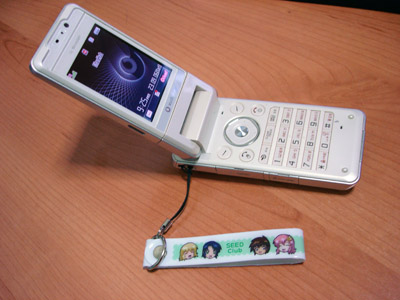
Vodafone 903SH
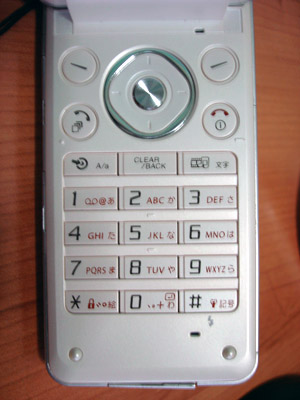
Vodafone 903SH
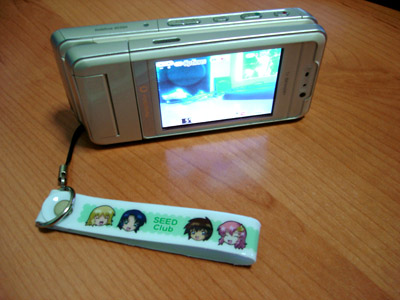
“Camera” mode
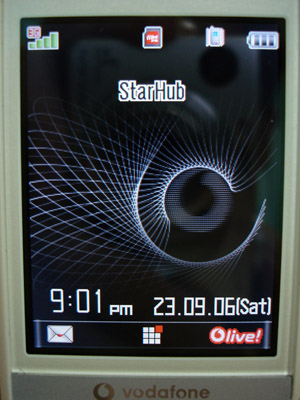
Standby screen
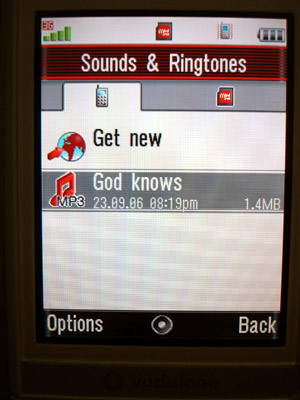
My current ringtone
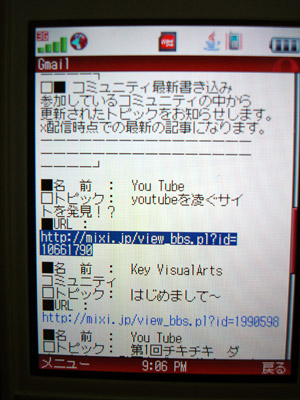
Gmail in Opera Mini
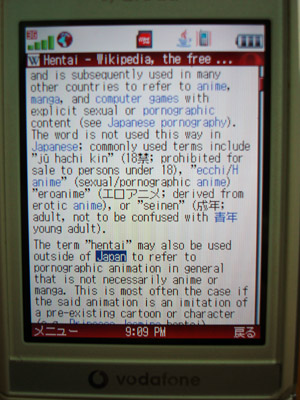
Wikipedia in Opera Mini
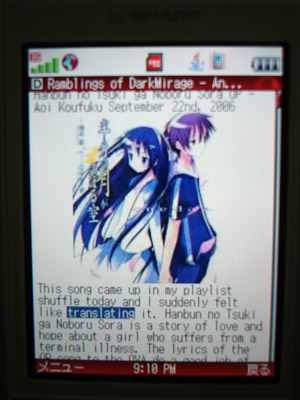
This blog in Opera Mini
Refer to my old post for picture quality. It’s pretty good for a 3.2mp phone, but certainly not as good as a 3mp digicam. :P
I am using the UK firmware now, which is actually pretty good except for the lack of Japanese input. That said, I’m planning to switch back to Japanese once a more stable version of the hacked firmware is released. After living without English T9 input for so long, I realized that I am not used to it any more… lol.
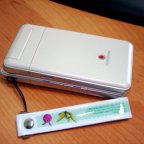



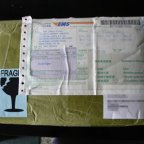

September 24th, 2006 at 2:52 am
Oh man, I’ve always wondered what those odd squares of blocks in magazines where. I’d figured out they were something to do with phones but I had no idea what!
Thanks for informing us what the hell they actually are ^^;
September 24th, 2006 at 3:23 am
You made a mistake with the pictures… You have a repeat of the Gmail picture.
September 24th, 2006 at 3:32 am
Nice phones. Pity there aren’t any local importers worth talking about for those, from what I recall…
September 24th, 2006 at 4:24 am
This is one of those things thats cool to play with for 10 min
then you realize it’s pretty useless
I got an unlocked smartphone from Europe that I could use in the US with my Tmobile sim card but stuff like internet was pretty useless because tmobiles network is different and it would take forever to sync with my bluetooth headset…so it was cool but eventually I just went and got a phone that my service provider supported and its more enjoyable
September 24th, 2006 at 4:59 am
Am i missing something here ? Phones like Nokia N73 (or W810) have better specs and look better than that vodafone 903SH. That japanes phone has a cheap plastic feeling to it.
September 24th, 2006 at 5:05 am
It’s hardly worth it in the US, yeah. Cell phones and their use are developing regional differences in line with local laws, regulation, price schemes, and market demands. People in the US just go for their blackberry/smartphone stuff instead of fancy, feature-rich all-in-one stuff that Japanese phones tend to be.
September 24th, 2006 at 5:07 am
I had that same exact phone when I was in Japan. Mine was an ugly sea-foam green color, though.
I’m not much into cell phones (I use a pretty bare bones model here in the States… all I need, really, is to be able to make calls), but I have to admit, that was a really cool phone.
September 24th, 2006 at 5:42 am
Go on, make more green with envy Y_Y
September 24th, 2006 at 6:11 am
It’s screen is certainly clearer than my one (a European 3G), but the 3G related icons and stuff are pretty much the same.
September 24th, 2006 at 8:14 am
I didn’t know you were into import phones.
I have a friend who pretty much a exotic phone collector, and from the way he was telling me, it seems like getting a unlocked phone is pretty expensive.
September 24th, 2006 at 8:53 am
Considering the last time I went to Japan which was about 6 years ago, I didn’t have a handphone and my peers had the trendiest Nokia 3310. And all the Japanese people had 3G phones with great colour screens.
Even now, the infrastructure for doing cool things with your phone still isn’t strong enough to make it worth it here.
September 24th, 2006 at 9:46 am
Now, I’m not saying the free market is perfect, but I think this is another case where a genuinely free market would aid consumers and businesses.
Regulatory sons of guns…
September 24th, 2006 at 10:15 am
That’s one sleek phone. Too bad the US won’t have anything as cool as that for another…lets say 10 years or so. *sigh* and 3G is all the rave in China/Japan area apparently. Well if importing phones were as easy as importing a game system then hell I would do it, but after seeing that I’m rethinking on that statement. Also I like your Gundam SEED (Destiny) phone strap. =D
September 24th, 2006 at 10:45 am
Thats a really spanky nice phone .. man .. u make me wanna get one too …. but I guess it would be uber expensive .. lol
But anyway … u dun really need a japanese phone to scan QR codes … it can be done with any camera phone and a simple sofware …
September 24th, 2006 at 11:24 am
Of course there are better phones in USA spec-wise, but generally they tend to lean towards smartphones and PDA hybrids. I hate those things. D:
Mac: A genuinely free market would mean that Japanese providers have to charge their people a lot more for their phones…
Tsubaki: It is way more expensive than what the Japanese get it for, but an unlocked Japanese V903SH is still cheaper than an unlocked 903SH provided by Vodafone in UK and HK.
Mayu: Yeah, because I’m using Vodafone’s UK firmware. :P
Hinano: That depends I guess. My phone works with everything my provider has for 3G, except for video streaming (which no one ever uses anyway). Internet is pretty much all I need besides regular phone functions actually. No one ever uses video calls… :(
September 24th, 2006 at 12:50 pm
Whats a good site for the US for reputable importers who can help with unlocking??? And for the phone you have DarkMirage, what type of price US are we looking at?
September 24th, 2006 at 1:35 pm
Not to be pedantic (I am, but that aside…)
The phones are artificially “cheap” because of the inflated price of the cell phone plans that subsidize them. The industry regulations that make it so hard to change providers only serve to lessen competition between them, which keeps overall prices higher (plans and phone, since you’re really paying for both).
In many other regions, as phone unlocking becomes more common, both phone and plan prices go down, while providers’ backend services become more standardized, because the companies are having to work harder to compete for service.
The higher phone prices in other markets are simply due to non-Japanese buying habits and non-Japanese business practices. Gradually, both sides are starting to pick up on the lessons of the other. But if the businesses desires are codified into law, the consumer is practically guaranteed to have the short end of the stick.
September 24th, 2006 at 3:28 pm
Exactly, they are heavily subsidized therefore they are not designed to be unlockable. A free market will force the industry to remove the subsidies, which means they have to charge more for the phone itself. Since Japanese generally don’t want to use foreign phones anyway, their providers have no reason to do so.
Tim: I really have no idea, but Howard forums is a good place to start looking. I paid about 500 USD for my 903SH when it first came out. Quite steep, but the resale price is about the same so it’s actually worth a lot more than normal trade-in value when I want to change to another phone.
September 25th, 2006 at 3:10 am
Well, part of what I was saying is that phones are also subsidized by plans in free markets where unlocking is common (even if not supported).
It’s the contract that retains the customer for that period, rather than the locking.
September 25th, 2006 at 10:37 am
I checked Howrds forums, seems to be the best bet :) Thanks!!! Also DarkMirage, how did you become part of the Seed Fan Club? I read all about it in Newtype, but never found out how to be apart!
October 4th, 2006 at 9:08 pm
hi, check with you does the white set gets dirty easily?
October 4th, 2006 at 9:10 pm
Nope, not as far as I can tell. In fact it has the added advantage that scratches on the top glossy surface are unnoticeable unlike the black set.
October 4th, 2006 at 11:30 pm
ok thanks, what about the possibility of non-glossy part turning yellowish?
October 7th, 2006 at 8:55 am
why do the japanese need to be so difficult (>_
October 14th, 2006 at 3:24 pm
I clicked on your contact tab and it did not provide me with an email address. Well, I think you have mine so please email me so I may contact you.
October 14th, 2006 at 7:49 pm
I can’t really tell if it turned yellow since I have nothing to compare it with, but it looks about the same as the glossy part.
October 15th, 2006 at 12:18 am
Hello again DarkMirage: If I plan on importing a Japanese Cell Phone, that’s unlocked, how can I find out if my carieer can be used with that phone??? I have Sprint.
October 15th, 2006 at 12:19 am
You have to ask your carrier or consult a forum… I have no idea about American carriers.
November 29th, 2006 at 3:37 am
Yea… Nokia N73 is a very very viable choice over the Sharp 903SH. It has everything the Vodafone 903SH have. 905SH is amazing, but it is not unlockable. 903SH is on ebay most of the time for about ~$500, make sure you get a stable firmware. N73 also suports 3G (complete with video calling), which means you could use it in Japan’s 3G network. It’s weird that phones outside Japan works in Japan, but not outside.. also, if you live in Europe, you could also get the phones to work, since Vodafone do operate in European countries. Even australia, and new zealand! America totally sucks when it comes to phones… we are still on EDGE… how sad is that??
November 29th, 2006 at 3:45 am
Sprint doesn’t work with SIMs. Cingular and Tmobile is the best to use with unlockable Japanese phones. Cingular also offer limited 3G service in limited metropolitan area (new york, Los Angelas, san francisco). America is getting there, but still long way to go. One thing that’s a huge obstacle for transforming America’s network to Japan’s is because the land mass the carrier have to cover. Japan is like the size of California so yea… filling up California with 3G is easy, but try doing that for like 50 states. Howard Forum is very informative. Also, Nokia is a much better choice, and Sony Ericsson are much better choice if you just don’t like to be everybody else. Nokia’s high profile series, and Sony Ericsson’s W series are good choice. I own the Vodafone 802SE (Sony ericsson’s phone) yea I imported that one, worked for 3 years, a solid phone. I just go NOkia’s n73, a very good phone, but audio quality isn’t as good as sony’s. I also have a Samsung E870, which i use for calling. If you are looking for a rich function phone, Nokia’s upcoming N95 is a very solid choice. I think it’s about 600-700 dollars. It has 5MP camera, along with all the Symbian OS function, and even GPS, and 3G. So yea. Toshiba are also known to make “cool” japanese phones like the T series (Vodafone 904T etc). Though they look good, they really arn’t that great. The only Japanese phone worth getting is Sharp as they make very good camera and display, but yea that’s about it.
December 13th, 2006 at 10:44 pm
Hey, I’m in Japan right now, and I’m interested in buying a 3G 811T Vodafone phone… I can’t get a straight answer if it will work in Aus!! And what is firmware?? Can you please help me, I want to buy it but I can’t without knowing it will work… I don’t need to import, and I don’t have a SIM or provider at the moment, so vodafone is fine…
Please e-mail me soon!!
Emily
January 7th, 2007 at 8:31 pm
Hi Emily,
Not sure if you are still in Japan, but I would strongly suggest you not buy a phone in Japan. The main issue here is that you would be locked into a contract of some sort and can only break it at great expense.
February 2nd, 2007 at 10:48 am
Wow…that’s indeed alot of trouble to go through, is it because of the strict telecom laws or importing laws in Singapore?
Before Sharp stopped prodution of it like 7 or 8 months ago, people here in China could easily shop a model of vodafone 903sh in a store that sells imported cellphones, and by a model of vodafone 903sh I mean an unlocked Vodafone Japan model, an HK model SX833, a TW model W-TX91, a Frech SFR model or any other models from other European countries by Vodafone, you name it.
February 2nd, 2007 at 12:33 pm
That’s a nice cell-phone,isn’t it?
The technic of mobile phone is the pride of Japanese.But we have great confidence to catch up with them.
February 2nd, 2007 at 3:49 pm
…..I wouldn’t say that.
We only get 2 carriers in China, both of which are state-runned, that’s the problem.
And I think a third state-runned carrier is getting the local standard 3G license, which means the 3G network here, once completed, won’t be compatible with those in any other countries. So what are they gonna do? Get phone makers like Nokia or Motorola, or even those from Japan to make exclusive cellphones for the local 3G network? I woundn’t count on that~
March 2nd, 2007 at 8:17 am
I just wanted to say THANK YOU SO MUCH for posting this! I’d done research previously about bringing Japanese phones to the US and the general consensus at the time was “You just can’t do it so there :P” which was very frustrating! But after seeing your post, I regained hope and went searching for forums that could help me. In the end, I have a white 903SH on its way to me with stable, fully unlocked Japanese firmware and I couldn’t be happier (#^_^#)
March 5th, 2007 at 7:42 pm
Hi there…
I have tried to look for Kuro on HWZ but to no avail…its tough to look for him omg..
Perhaps you can email me his contact directly?
I wish to purchase a unlocked vodaphone from him and yea it seems he is the only retailer i can trust…
Will like to find out the kindda models he can unlock..or carry in…
And choose one that I like from there..
Wondering if there are any pink models available..
I cant remember which one my friend has…but hers is a pink vodaphone that carries Mickey/ Minnie mouse themes insde…
She is having problems with it lmao…because she didnt get it from Kuro…
Thanks a million ^^
March 5th, 2007 at 7:49 pm
BTw…i see that you have a Gseed Club tag on your accessory! ^^
Guess you are a Gseed fan too? =DD
Its Julia here…or Makoto_Youko on sgcafe.com (the flame-flame-paradise =.=) under the cosplayer community..
Ferlyn is da girl who bought the pinky phone…
She is so screwed…her messaging interface keeps recurring the similar problems…and her reception is getting hazy…lolx.. >
March 23rd, 2007 at 3:06 pm
I’d like to purchase one of their Softbank 3G Sharp series and was wondering if you know of any affiliation in the Philippine market that would do unlocked GSM? Now is this only applied to Vodafone Models? If not, that Kuro gentlemen; how is he contacted again? I know Philippines is on the catch up of technological affairs, especially in mobile devices, so I figured alot of them probably has knowledge, since I’m Filipino myself. Please don’t hesitate to reply to me via e-mail and your response would gladly be anticipated and appreciated at the same time!
Sincerely,
Rondel
March 30th, 2007 at 1:27 am
it arranges one of this for me? …. one cell phone of this or one that you finds in the garbage orders pra me in the band? it has my email until more…
April 6th, 2007 at 2:51 am
Hey,
Does anyone know where I can get this mobile unlocked over the internet at a good price.
Thank you
Cheeseycheese
May 1st, 2007 at 9:54 pm
I’m simply green with envy. I’m going to hunt for this Kuro dude. XD Clearly your phone works with starhub which I’m on as well.
I really wish companies like Sony Ericsson would simply translate their phone interfaces and include Japanese input. I wonder how difficult it is to do that. Geez.
July 12th, 2007 at 11:59 am
I also have a Vodafone Sharp 903SH, and have had a contract for over a year with Japan vodafone (using it in Korea and UK). Now I want to cancel the contract but use it in Hong Kong (and UK if possible). Where do I go in HK to unlock it?
July 21st, 2007 at 6:59 pm
can docomo p900iv be used in the philippines??
September 8th, 2007 at 5:33 pm
how much is the fone
October 15th, 2007 at 7:06 pm
i actually use imode phone to email friend in japan. it would be great if i can use japanese input. but then it would like sms if i choose to get usable jap phone?
October 18th, 2007 at 11:22 am
hey, i was wondering… do you know if you can unlock softbank phones??
im in the states and i am dying to get a japanese phone >.<
btw. im japanese lol
October 27th, 2007 at 1:24 am
Soooo…all there is to do is buy phone and get it unlocked then stick my sim card into it??? Im using a samsung with T-mobile…the 903sh can use a sim right???
November 8th, 2007 at 5:59 pm
vodafone903SH models from SOFTBANK is unlockable ?? When I was in Japan I bought silly SHARP cell phone with the 5 mega pix camera, I should have bought the 903SH.
Plase help
November 24th, 2007 at 12:26 pm
Hi there,
me, I am actually “just” looking for a GSM+GPRS or 3G phone that can do Japanese input. Doesn’t matter if it’s from Japan or not. Seems pretty hard to find one. Any ideas, anyone?
December 1st, 2007 at 11:05 pm
I want to unlock the Softbank 920SH
Can anyone help me?
December 6th, 2007 at 2:52 am
does it have a sim slot??????!!!!
December 6th, 2007 at 6:21 pm
Yes it does.
December 12th, 2007 at 8:02 pm
yes it does… it’s 3G GSM/CDMA (it has a USIM)
what do i need to do to unlock it? fully?
Softbank 920SH
December 14th, 2007 at 2:58 am
At best the phone is only being analyzed, and has no unlock availble. It could be a little while for one to come out.
January 6th, 2008 at 1:51 pm
Stumbled here while going through exotic phones. Do you know where I can get your model? Or perhaps the older Vodafone ones, not Softbank ones? I believe they are only available in the second hand market ad rare for them to be brand new.
January 6th, 2008 at 10:09 pm
i from the philippines and i have a toshiba 903.. i wanted to swap it with sharp 903 because 903ts are too bulky compared to 903shs.
plus 903sh got a 3.2mp cam.. i love the macro mode XD
January 7th, 2008 at 12:26 am
All the links you listed above were broken or something… Could you give me a link to a japanese cell phones selling store thingy? I would be greatly appreciated..
January 7th, 2008 at 12:39 am
there’s this phone that claims to be unlocked from japan on this website
http://www.alibaba.com/catalog/11128276/Brand_New_Panasonic_X800.html
but i don’t know if cingular can have a plan for it does anyone know?
the cell phone is called Panasonic X800
January 11th, 2008 at 6:17 pm
hi!
can a 920sc phone from japan be used in the philippines?
do you know where i can convert it to open line so it can used here in the philippines?
i really need your help…
hope you can advice me with this. thank you very much!
January 23rd, 2008 at 6:22 pm
Anybody know where to or how to unlock japanese GSM cellphones?
January 24th, 2008 at 11:00 pm
hi minori.. i have question also about the samsung 920SC.. my wife bought that for me yesterday in japan. but i don’t have any idea if i can use it here in philippines…? nagamit mo ba siya dito..? thanks in advance.
February 4th, 2008 at 12:03 pm
I really really want a japanese cell phone. But 1) i don’t know which kind works in the United states (if any do) and 2) unlocking the japanese phone is confusing. could you please help me figure it out. I doubt i will be able to get one right away but i still want to know in advanced. can you please help me, the japanese phones seem really cool.
Thanks alot,
Summer
February 15th, 2008 at 8:27 am
Hello, I am from Holland and seeking for a way to get an au sony ericsson W44S…
Can it be unlocked and even if it can’t is there a way to get it without being stuck to a contract since I will be moving to japan in a year.
Loved reading your article, I’ve been busy reading all day but never got past ”its impossible to get, stop looking” XD
Just like someone who posted before me said your article has given me hope ^^
February 24th, 2008 at 7:16 pm
Hello, I am from Maldives and seeking for a way to get an au sony ericsson W44S…
Can it be unlocked and even if it can pls send me a mail to sixteeneleven_1611@hotmail.com
April 13th, 2008 at 1:31 pm
i got a softbank 9202h im wondering if it works here in the philippines, if not anybody can help me where can i unlock my fon? i don’t know which kind of 3g softbank model works in pinas, i really love japanese phones cool and high tech.. pls send me email to levi_nice@yahoo.com
May 14th, 2008 at 7:24 pm
pls someone help to open my softbank 920SH, i really badly your help , tnx!!!
July 13th, 2008 at 10:24 pm
อยากได้อุปกรณ์ของโทรศัพท์รุ่นนี้มาก ๆ ครับ ทั้งแบตฯ, สมอลล์ทอล์ค, ที่ชาร์จ, สายเคเบิ้ลดาต้า หาให้หน่อยครับ
(I want some accessories of this model phone, help me pleas!!!!
August 15th, 2008 at 6:14 am
Hey if your up to it, do you think you could list the phones that you know are able to be hacked to my email adress. I would greatly appreciate it and would save me a couple of hours of searching the web for them lol. Also thanks for In-depth information, probably the best I’ve seen on the web about this topic.
August 29th, 2008 at 12:47 am
yea I’ve been wanting a keitai for a while now and just drooling at the screen at the new FOMA F906i and that old Softbank 920SH.
I’ve been trying to find some prices that are well within my budget or trustworthy sites that i could purchase them from.
I really enjoyed reading your blog and yes i QR reader function is wonderful for getting information quick. I have many magazines that come from japan and frequently buy books and etc from Kinokuniya in SF.
September 8th, 2008 at 5:07 am
Thanks for having such a great resource for iPhones. I\’ve been searching all over for this. http://www.iphonehub.com/iPhone/Chinese-iPhones
September 10th, 2008 at 2:24 am
hi..my name is putri..i have the same problem about samsung 920SC, i want to use it in indonesia using Telkomsel as a provider..plizzz…help me!!onegai…
September 15th, 2008 at 7:30 pm
hi i have a problem with my japanese fone 811T softbank i cant use it here in philippines…do it have the unlocking codes alreadyu?can you help me through this? email me pls…
simple_chris69@yahoo.com
September 18th, 2008 at 3:33 pm
hi, may i know do you still buy and import phones from Jap? Where do you find the person who is willing to import the phone from overseas to you? Are you from SG?
Mail me yeah?
(:
October 14th, 2008 at 12:57 am
who cares , the japs are fuked in the head anyways they make all thier people be ruled by buisnesses, in usa its vise versa, thus making it fair for the common people. stick to your american phones like htc. and besides thiers an LG phone that does the same thing rofl. WASTE OF MONEY!
November 8th, 2008 at 2:48 pm
hey i know some friends of mine who managed to get thier hands onto some Sharp phones from japan though. E.g 905i. isn’t that a NTT DOCOMO product? they can use it here in Australia just fine as well. mail me yeah? :)
February 22nd, 2009 at 3:35 am
Looking for a Japanese phone and I am so lost. I live in the US and I really have no idea where to start. Any idea where I would be able to get one in the US?
March 9th, 2009 at 5:35 pm
Hi, can i check with you how do i see that the Jap phones i see is able to be used in S’pore(with a hypersim) & how does the hypersim works? Thanks
April 27th, 2009 at 2:15 am
how much is the phone?
April 29th, 2009 at 5:30 pm
hello,
i need to know if i have to discard this fone i have from japan
it’s a sony ericsson w41s (au by kddi).
i will be greatfull if you can advise me on this phone.i have it and cannot use it maybe i need to throw it in to the sea and fotget owning a japanese fone
edward
May 1st, 2009 at 1:31 pm
i’m from the philippines, are there people selling it in the country?(for thise filipinos who commented and has one)
May 21st, 2009 at 3:42 pm
hi can i noe whether u wiling to sell ur v903sh to me?kindly email me =)
June 6th, 2009 at 7:55 pm
well….you CAN use KDDI because they have an American branch and you don’t even have to go thru all the unlocking crap. just visit this site, order your phone and tada! ^^
https://store.kddimobile.com/Store/WebObjects/PostPaidStore?language=English
June 19th, 2009 at 4:11 am
sorry if this was covered already but where did you get your Vodafone 903SH
July 22nd, 2009 at 12:34 pm
So…on your unlocked phone…you CAN use the internet?? how??
December 1st, 2009 at 3:13 am
hi
love u all babyyyyyyyy i wanna fuckkkkkkkkk u plz help mee about this
December 20th, 2009 at 5:55 pm
i can unlock any mobiphone,call me 01685476679 i will help you!!
January 7th, 2010 at 12:45 pm
Um.. I really want to find a nice japanese phone and find the cheapest one ^.^;;;
that i know is impossible but do you know any sites that are helpful?
January 18th, 2010 at 12:58 am
@tammy: The Sanyo Eclipse seems to be good.
You can get through Sprint directly or through KDDI America (see link posted by yamato).
Although I think you can only get them in certain zip codes (through KDDI). For example, where I live right now you can only get an LG english model, but in, say, Kansas City or Chicago, you can get them. I live in a very small town, so my town is not a good reference for availability. You can also transfer your current number.
darkmirage, thanks for giving me hope (^^)
February 12th, 2010 at 5:38 am
is there any japanese phone which will work in uk
anybody please helpppppp!!!!!!!!!!!!